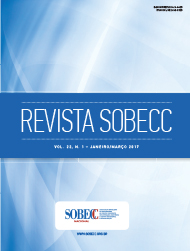Implementation and use of automated traceability system in the central sterile supply department
DOI:
https://doi.org/10.5327/Z1414-4425201700010009Keywords:
Sistema de gestão da qualidade, rastreamento, esterilização, centro de esterilizaçãoAbstract
Objective: To describe the implementation of the automated traceability system in Central Sterile Supply Department (CSSD). Method:
Experiment report developed between 2011 and 2014. The traceability system best suited to the profile of the institution was chosen, and its basic license
was purchased. The proper infrastructure and training were also adapted. Results: We decided to trace cases with barcodes. We began with the database;
the cases were registered, and the labels printed. After one month, three cases were registered and 81 traceable units were created; in the third month,
698 units were created; after nine months, 7,669 units were created. Of the total number of stages, 5.0% are omitted; 4.2% are corrected; and 0.8% loose
traceability owing to human error. Management is performed through reports and the discussion of results. Total implementation lasted nine months.
Conclusion: Even with the incipience of the method, this study demonstrates that the automated traceability system benefits the hospital’s CSSD.
References
Taube SAM, Meier MJ. O processo de trabalho da enfermeira
na central de material e esterilização. Acta Paul Enf.
;20(4):470-5.
Pinto MB, Vilas-Boas, VA, Freitas, MIP. Validação do processo
de limpeza de artigos odonto-médico-hospitalares: uma revisão
integrativa. Rev Sobecc. 2013;18(1):64-72.
C o s t a EA M , C o s t a EA , G r a z i a n o K U , P a d o v e z e M C .
Reprocessamento de produtos médicos: uma proposta de
modelo regulatório para hospitais brasileiros. Rev Esc Enferm
USP. 2011;45(6):31-7.
A gência Nacional de Vigilância Sanitária (ANVISA). Resolução da
Diretoria Colegiada RDC nº 15, de 15 de março de 2012. Dispõe
sobre requisitos de boas práticas para o processamento de
produtos para saúde e dá outras providências. Diário Oficial da
União, Brasília (DF); 2012.
O`Keefe J. Right on track – new software system improves productivity,
accuracy and accountability for Medical Device Reprocessing. Conect
Publis. 2010;35(9):12-3.
Mattos LM, Moura MA, Maldonade IR, Silva EYY. Produção segura e
rastreabilidade de hortaliças. Hortic Bras. 2009;27(4):408-13.
Caquas S, Chapirot C, Coquard A, Dieu B. Using the T-Doc® software
application to calculate sterilization costs. Zentr Steril. 2010;18(3):75-85.
Kuhlman C, Berg A. Role of case carts in sterile management. Hosp
HealthCare. 2012;10(2):11-2.
Williamson J.E. Advance instrument tracking paves the way for
quality. Heathcare purchasing news. 2012;20(2):5-10.
A lter S. Information systems: a management perspective [dissertation].
San Francisco: University of San Francisco; 1991.
Downloads
Published
How to Cite
Issue
Section
License
By publishing in Revista SOBECC, authors retain the copyright of their article and agree to license their work using a Creative Commons Attribution (CC BY 4.0) International Public License, thus accepting the terms of this license. The CC BY 4.0 license allows others to distribute, remix, adapt, and create from the published article, even for commercial purposes, provided they give due credit to the creators of the work (authors of the article).
The authors grant to Revista SOBECC the right of first publication, to identify itself as the original publisher, and grant to the journal a non-exclusive license to use the work in the following ways: (1) to sell and/or distribute the article in hard copies and/or in electronic format; (2) to distribute parts and/or the entire article in order to promote the journal through the internet and other digital and printed media; (3) to record and reproduce the article in any format, including digital media.
With this license, authors can enter into separate contracts for non-exclusive distribution of the article (e.g., publishing in an institutional repository or as a book chapter), with acknowledgement of authorship and initial publication in Revista SOBECC. Authors are encouraged to publish and distribute their work online after publication in the Revista SOBECC, as this can increase the article's visibility and impact.
In line with the journal's policies, each published article will be assigned a CC BY 4.0 license, which will be visible on the abstract page and in the PDF of each article with the respective link to the license terms.











